

|
|

Shine up (Claretta SP-99) from Kuraray


Dual performance
of photo-catalytic reaction and chemical neutralization.
In general, deodorizing can be carried out by
several ways; such as chemical reaction with odor particle, physical absorption,
sensuous masking or biological method (anti-bacterial agent to kill germs to
prevent odor generation.)
SHINE-UP has been jointly developed by Kuraray Co. Ltd. and Takeda Chemical Co.,
Ltd. It hires the chemical neutralizing reaction and photo-catalytic reaction
activated by special ceramics containing metal.
Light can clean air by photo
catalysis.
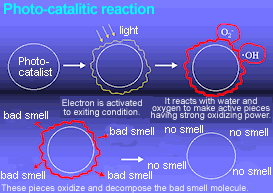 |
The
deodorizing system of SHINE-UP consists of 2 stages; absorption of odorant
particle into the ceramic in the fiber, followed with photo-catalytic
reaction leads to decomposition of odorant molecule into CO2 and H2O by
the oxidant generated by the light radiation. |
Can it work under fluorescent
lamp?
The photo-catalytic reaction is carried out by
the radiation of UV below 400 nm wavelength normally found both in sunlight and
in-door light source. Thus fairly weak light source of fluorescent lamp can
develop the deodorization reactions.

Life full of odor
We are surrounded by various unpleasant odors
such as sweat, cigarette, pet smell and also the aged person smell. What brings
those smells? You smell the ammonia in a toilet room, which is generated by
decomposition of urea by bacteria. The body odor is caused by the decomposition
of sebum by epidermal bacteria such as staphylococcus. (Sweat itself is not
odorant at all.)
●Typical
bad odorants
| Cigarette fume; |
ammonia,
acetaldehyde, |
| Sweat; |
acetic acid, |
| Body odor; |
iso-valeric acid,
acetaldehyde, nonenal (newly found in aged person smell) |
| Pet odor; ammonia |
iso-valeric acid |
| Rotten food; |
hydrogen sulfide, dimethyl
sulfide |
| Smell of a toilet; |
ammonia, methyl-mercaptan,
dimethyl sulfide |
Shine-Up, new odor buster in
our daily life.

SHINE-UP can absorb and decompose the smell by
dual deodorizing mechanism: chemical neutralization reactions and
photo-catalytic reactions.
Both acid and alkaline component of odors are chemically neutralized to be
odorless. The neutral component of bad-smell is most hard to be deodorized. But
SHINE-UP is effective against the neutral component as well by photo-catalytic
reactions.
Confidence in deodorizing
various smell quickly.
| <Deodorizing
and discharging of odorant> |
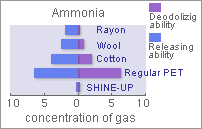 |
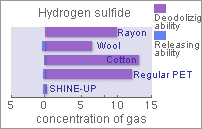 |
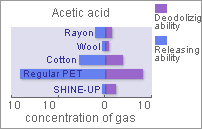 |
Evaluation
method of deodorizing (Tedlar-bag method):
3g of specimen fabric and 3L of the odorant gas are put in 3L Tedlar-bag.
After the predetermined retention time (2 hours and 24 hours), the
concentration of odorant gaseous particles is measured.
Evaluation method of discharging of odorant (Kuraray method):
The specimen tested in above Tedlar-bag method and fresh air is put in
the 3L Tedlar-bag. The bag is heated at 40℃ for 1 hour to
discharge the odorant particles from the specimen. The concentration of
discharged gaseous particles is measured. |
The light energy deodorizes
neutral component
|
|
The chart
indicates the comparison of deodorizing effect against acetaldehyde, a
neutral component, in different conditions; under irradiated light and
without light. SHINE-UP demonstrates enough deodorizing ability under
the light of only 30W bulb. Even such a small light energy develops
photo-catalytic reactions effective to eliminate odor. |
| All data is measured by
K-1 method of Japan Synthetic Textile Inspection Institute Foundation |

In case of conventional deodorizing materials
such as activated charcoal typically used for refrigerator, they can be
saturated with absorbed odorant particle and lose the absorbing ability after
the saturation.
But in case of SHINE-UP, it can decompose bad odors without such saturation and
keeps the deodorizing performance permanently, as far as the light reaches to
the fiber.
Repeat deodorizing ability
against ammonia
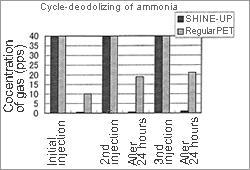 |
| K-1 method of
Japan Synthetic Textile Inspection Institute Foundation |
1g of sample and 3L ammonia gas in fixed
concentration are entered to 3L Tedlar-bag. After the fixed retention
time (24 hours), the concentration of remained gas is measured. Then,
the fixed volume of ammonia is added to the bag, after this, the same
operation is repeated. The higher is the number of repeat times, the
more clearly deodorizing ability of SHIE-UP is excellent. |

 |
As for deodorizing by topical treatments on
fiber, they have several drawbacks, such as tendency to lose the effect
after washing and to become hard in touch and availability with limited
colors.
 SHINE-UP
is produced by compounding deodorant ceramics in the polymer through
melt-spinning process. The sheath-core type yarn is available as DTY. SHINE-UP
is produced by compounding deodorant ceramics in the polymer through
melt-spinning process. The sheath-core type yarn is available as DTY.
|
|
It is washable
Because of being compounded in extrusion
process, SHINE-UP has higher durability to maintain the performance after
repeated washing. The fabric made with SHINE-UP has physical properties
similar to that of regular polyester, it is easy to dye and finish and
retain texture of the fabric without chemical treatment.
|
|


![]()






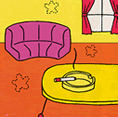





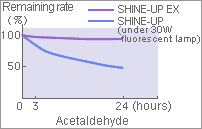




 SHINE-UP
is produced by compounding deodorant ceramics in the polymer through
melt-spinning process. The sheath-core type yarn is available as DTY.
SHINE-UP
is produced by compounding deodorant ceramics in the polymer through
melt-spinning process. The sheath-core type yarn is available as DTY.